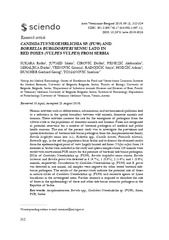| dc.creator | Sukara, Ratko | |
| dc.creator | Juwaid, Salem | |
| dc.creator | Ćirović, Duško | |
| dc.creator | Penezić, Aleksandra | |
| dc.creator | Mihaljica, Darko | |
| dc.creator | Veinović, Gorana | |
| dc.creator | Radojičić, Sonja | |
| dc.creator | Hodzić, Adnan | |
| dc.creator | Duscher, Gerhard Georg | |
| dc.creator | Tomanović, Snežana | |
| dc.date.accessioned | 2020-06-03T14:35:29Z | |
| dc.date.available | 2020-06-03T14:35:29Z | |
| dc.date.issued | 2019 | |
| dc.identifier.issn | 0567-8315 | |
| dc.identifier.uri | https://vet-erinar.vet.bg.ac.rs/handle/123456789/1767 | |
| dc.description.abstract | Human activities such as deforestation, urbanization, and environmental pollution lead to a reduction in the spatial boundary between wild animals, domestic animals and humans. These activities increase the risk for the emergence of pathogens from the sylvatic cycle in the population of domestic animals and humans. Foxes are recognized as potential reservoirs for a number of bacterial pathogens of medical and public health concern. The aim of the present study was to investigate the prevalence and spatial distribution of bacterial tick-borne pathogens from the Anaplasmataceae family, Borrelia burgdorferi sensu lato (s.l.), Rickettsia spp., Coxiella burnetii, Francisella tularensis, Bartonella spp., in the red fox population from Serbia and to discuss the obtained results from the epidemiological point of view. Legally hunted red foxes (Vulpes vulpes) from 14 localities in Serbia were included in the study and spleen samples from 129 animals were tested with conventional PCR assays for the presence of bacterial tick-borne pathogens. DNA of Candidatus Neoehrlichia sp. (FU98), Borrelia burgdorferi sensu stricto, Borrelia lusitaniae, and Borrelia garinii was detected in 6 (4.7%), 1 (0.8%), 2 (1.6%) and 1 (0.8%) animals, respectively. Co-infection by Candidatus Neoehrlichia sp. (FU98) and B. garinii was detected in one animal. All samples were negative for other tested bacterial tick-borne pathogens. The results of the present study indicate the potential role of foxes in natural cycles of Candidatus Neoehrlichia sp. (FU98) and causative agents of Lyme borreliosis in the investigated areas. Further research is required to elucidate the role of foxes in the epidemiology of these and other tick-borne zoonotic pathogens in the Republic of Serbia. | en |
| dc.publisher | Univerzitet u Beogradu - Fakultet veterinarske medicine, Beograd | |
| dc.relation | info:eu-repo/grantAgreement/MESTD/Basic Research (BR or ON)/173006/RS// | |
| dc.rights | openAccess | |
| dc.source | Acta Veterinaria-Beograd | |
| dc.subject | Anaplasmataceae | en |
| dc.subject | Borrelia spp. | en |
| dc.subject | Candidatus Neoehrlichia sp. (FU98) | en |
| dc.subject | foxes | en |
| dc.subject | PCR | en |
| dc.subject | Serbia | en |
| dc.title | Candidatus neoehrlichia sp. (fu98) and borrelia burgdorferi sensu lato in red foxes (vulpes vulpes) from Serbia | en |
| dc.type | article | |
| dc.rights.license | ARR | |
| dcterms.abstract | Михаљица, Дарко; Радојичић, Соња; Ћировић, Душко; Дусцхер, Герхард Георг; Ходзић, Aднан; Веиновић, Горана; Сукара, Ратко; Јуwаид, Салем; Пенезић, Aлександра; Томановић, Снежана; | |
| dc.citation.volume | 69 | |
| dc.citation.issue | 3 | |
| dc.citation.spage | 312 | |
| dc.citation.epage | 324 | |
| dc.citation.other | 69(3): 312-324 | |
| dc.citation.rank | M23 | |
| dc.identifier.wos | 000489257700006 | |
| dc.identifier.doi | 10.2478/acve-2019-0026 | |
| dc.identifier.scopus | 2-s2.0-85073939127 | |
| dc.identifier.fulltext | https://vet-erinar.vet.bg.ac.rs/bitstream/id/728/1766.pdf | |
| dc.type.version | publishedVersion | |

